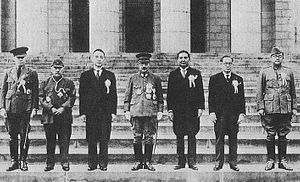Japan’s massive offensive to conquer Southeast Asia began to unfold seventy-five years ago this week. In territorial extent, it is among the largest, most successful series of military operations ever conducted. The Japanese offensive managed to destroy the front line naval assets of two peer competitors, sinking seven capital ships without loss. It also managed to capture the greater portion of what is now ASEAN, the most economically dynamic region in the world. Although Japan would only hold the territory for four years, the offensive helped end formal colonialism in East Asia.
The advance
In the years prior to the opening of the Pacific War, Japan had already made significant territorial acquisitions. It came into possession of Formosa following the Sino-Japanese War, and Korea after the Russo-Japanese War. The League of Nations placed several Pacific island chains under Japanese control after World War II. In 1931 the Japanese Army seized Manchuria; in 1937, it began a war against China that would lead, by 1941, to the occupation of much of the north and east of the country, as well as several coastal enclaves. Finally, in 1941 Japan occupied French Indochina, giving it critical bases for the advance into the rest of the region.
Japan’s war with the West began with the attack on Pearl Harbor on December 7, which destroyed the greater portion of the capital ship strength of the U.S. Navy. Invasions of the Philippines, Malaya, and Thailand followed in the next few days. Borneo and Sumatra suffered invasion later in the month. In January the Japanese Army began its seizure of the greater part of Burma; in February it captured the British military fortress at Singapore, and invaded Java. In March Japanese troops captured Rangoon and landed in New Guinea and the Solomon Islands. Japanese victories would continue through April.
The peak
How did a state with a backward economy (compared to the United States and the United Kingdom) manage to conquer the great part of Southeast Asia within three months? From the vantage point of the 1939 Battle of Khalkin Gol, where the Soviets simply outfought and out-muscled the most elite elements of the Japanese Army, the prospects for success looked grim. But the Japanese had good timing. The British were occupied in Europe, fighting the Germans and the Italians. The Dutch and the French were literally occupied, and in any case their colonial regimes enjoyed little local support. The pre-war American military buildup had not yet taken full shape. Moreover, trends in Japanese training and equipment procurement coincided, through both good planning and good fortune, with the moment of Western weakness.
The end
But of course, it didn’t last. Japan’s military momentum ended at Midway and Coral Sea; the long battle of attrition over the Solomon Islands gave the United States plenty of time to recoup its strength; when the counter-offensive began in earnest, the Japanese Empire collapsed quickly. Japan’s economy could not keep pace with the U.S. either on quantity or quality of military material, and as the war drew on the Japanese industrial base simply collapsed under direct and indirect assault.
A modern military success of this scale is almost unimaginable. For one, in the contemporary technology environment, no state could keep all of the moving parts of its offensive concealed nearly as successfully as the Japanese. For another, the existing regimes of East Asia (and most of the rest of the world) have a degree of genuine popular foundation; they would not topple at the arrival of a few brigades.
However, Japan’s brief seizure of East Asia had lasting effects on the region. The colonial regimes in Vietnam, Burma, and Indonesia quickly collapsed, followed by the British Raj. The United States ended formal control of the Philippines, although it had planned to leave even before the war. The Sino-Japanese War gave the Chinese Communists an opportunity to seize power, which they took advantage of. In short, the Japanese managed to rewrite the map of East Asia in four months, and no one has ever managed to put it back the way it was.

































